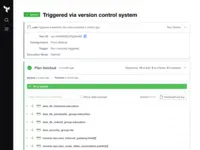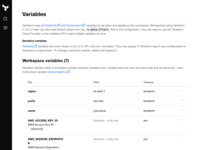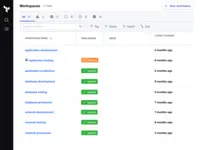Overview
What is HashiCorp Terraform?
Terraform from HashiCorp is a cloud infrastructure automation tool that enables users to create, change, and improve production infrastructure, and it allows infrastructure to be expressed as code. It codifies APIs into declarative configuration files that can be shared amongst…
HashiCorp Terraform - make IT boring again (in a good way...)
Terraform - Codify your infrastructure
The main reason for using Terraform is to allow us to reliably …
The de facto tool for provisioning infrastructure today
Cloud Engineer review of Terraform
Terraform - Best Cloud-agnostic Infrastructure Provisioning Tool.
Terraform Review
Really good tool for Infrastructure
Terraform for Automation
Terraform Review
Terraform Review
Terraform is the Perfect Tool for Building Infrastructure as Code
Infrastructure as code, finally!
Infrastructure Configured
A great automation tool for everyone
Makes your environment more reliable and easily replicable.
Reviewer Pros & Cons
Pricing
Open Source
$0
Team & Governance
$20/user
Enterprise
Contact sales team
Entry-level set up fee?
- No setup fee
Offerings
- Free Trial
- Free/Freemium Version
- Premium Consulting/Integration Services
Product Demos
Infrastructure Pipelines with Terraform Cloud
Product Details
- About
- Competitors
- Tech Details
- FAQs
What is HashiCorp Terraform?
Terraform creates and manages resources on cloud platforms and other services through their application programming interfaces (APIs). Providers enable Terraform to work with virtually any platform or service with an accessible API.
HashiCorp Terraform Features
- Supported: Manage any Infrastructure
- Supported: Track your infrastructure
- Supported: Automate changes
- Supported: Standardize configurations
HashiCorp Terraform Screenshots
HashiCorp Terraform Competitors
HashiCorp Terraform Technical Details
| Deployment Types | Software as a Service (SaaS), Cloud, or Web-Based |
|---|---|
| Operating Systems | Unspecified |
| Mobile Application | No |
Frequently Asked Questions
Comparisons
Compare with
Reviews and Ratings
(122)Community Insights
- Pros
- Cons
- Recommendations
Fast and Reliable Infrastructure Deployment: Users appreciate Terraform's ability to deploy infrastructure quickly and reliably. Several reviewers have mentioned that they were able to provision resources efficiently, saving them time and effort in the deployment process.
Modular Approach with Reusable Modules: The use of modules in Terraform is highly valued by users, as it enables repeatability and encourages code reuse. Many reviewers have stated that they find it easy to share and reuse functionality across deployments, promoting collaboration and consistency among teams.
Large Ecosystem of Modules for Various Providers: Users highly value the extensive ecosystem of modules available in Terraform for various providers. Numerous reviewers have stated that this allows them to easily access strong default configurations for many services, saving them time and effort in setting up their infrastructure.
Complex Documentation: Many users have found the documentation for the new language to be complex and lacking clear explanations, making it difficult for them to understand and use Terraform effectively. They express frustration with the lack of concise and intuitive explanations in the documentation, which hinders their ability to grasp key concepts.
Challenging Rollback Operations: Users have expressed difficulty in performing rollback operations as it must be done through version control. This process is seen as cumbersome and unintuitive, requiring extra steps that could be simplified with a dedicated rollback feature within Terraform itself.
Unusual Language Design: The language used in Terraform is considered unusual by many users, which makes it challenging for new users to understand and navigate the codebase. Some users find it unconventional compared to other infrastructure-as-code tools, leading to confusion when reading or modifying existing code.
Users have provided several recommendations for Terraform based on their experiences with the tool for automating cloud infrastructure management.
First, users suggest taking the time to understand and implement Terraform modules properly. This recommendation emphasizes the importance of familiarizing oneself with the module system in order to effectively leverage the capabilities of Terraform.
Second, users recommend reading through the documentation and reaching out to Hashicorp for assistance when facing issues. By doing so, users believe that they can overcome any challenges they encounter and make the most of Terraform's features.
Lastly, some users advise considering other Infrastructure as Code (IaC) platforms, but acknowledge that Terraform is a great and flexible open-source option. This recommendation highlights the need for users to evaluate different options before making a final decision on their cloud infrastructure automation tool.
Attribute Ratings
Reviews
(1-11 of 11)Terraform - Codify your infrastructure
The main reason for using Terraform is to allow us to reliably deploy AWS infrastructure and have change control/management over changes made to any infrastructure. It gives us the ability to roll out new AWS accounts very easily and quickly, using Terraform with a code repository also provides pipelining/PR approval etc.
- Deploy infrastructure quickly & reliably
- Repeatability thanks to use of modules
- Dry runs thanks to the plan command
- A new language to learn
- Documentation, specifically examples are often complex and do not explain things very well
- No rollback capability built in, must be done through version control
Terraform is well suited to any size of team thanks to the use of workspaces and proper use of version control will allow work on branches without upsetting anything in production.
The de facto tool for provisioning infrastructure today
- Support all major cloud providers
- good documentation
- good support of providers
- We need the tool to be easier to code logic similar like the programming languages we use
- Creating a CICD pipeline is hard
- having a single state file is a disadvantage, terraform runs slow if it's not running in the same network where the state file is
Terraform framework can be considered complicated to write efficient code, especially if you are doing some more complex use cases.
Creating efficient CICD pipelines is quiet challenge , I believe Terraform future will be replaced by Kubernetes operators.
Really good tool for Infrastructure
- Developed in Go is really efficient and fast
- Use a really simple language easy to learn
- The modular system is the state of the art in development
- The need to keep one standard between versions
- [I feel] The migration tool require improvement when you upgrade from one version to another
- Import the infrastructure into the config require more work
Terraform Review
- Terraform makes cloud state management much easier than natives tools supplied with the service providers.
- If you opt for the business edition, you can get a private module registry. This allows for best practices modules to be distributed across the company and allows for more re-usability.
- The providers do a fantastic job staying up to date on the latest changes from the Cloud providers features updates. This makes taking advantage of the new features launched not a problem.
- The language itself is readable and has had upgrades recently to make it more powerful for repeatable patterns.
- The errors generated by the plan and preview commands are pretty cryptic, it can be hard for newcomers to the scripting language to understand how to address problems.
- Access controls around workspaces is limited which makes it harder to secure reduce the scope of teams ability.
- Analytics around user usage, applies and plans would be helpful for managemenet.
If you are leveraging AWS and have a team already comfortable with their offerings like Cloud Formation, I would choose to stay or start in the AWS eco-system.
Terraform Review
- Terraform has a large ecosystem of modules for a variety of providers
- For many services, Terraform provides strong default configurations
- Terraform is completely and totally superior to using CloudFormation directly
- The language itself is a bit unusual and this makes it hard for new users to get onboarded into the codebase. While it's improving with later releases, basic concepts like "map an array of options into a set of configurations" or "apply this logic if a variable is specified" are possible but unnecessarily cumbersome.
- The 'Terraform Plan' operation could be substantially more sophisticated. There are many situations where a Terraform file could never work but successfully passes the 'plan' phase only to fail during the 'apply' phase.
- Environment migrations could be smoother. Renaming/refactoring files is a challenge because of the need to use 'Terraform mv' commands, etc.
- Terraform does a great job of making cloud resources available as code. Essentially, it provides building blocks for the resources available in the cloud.
- I use the open source version of Terraform and I appreciate the user experience at the command line. Using the switches available, the CLI lends itself to a flow of formatting and validating code before a plan is developed, reviewed, and applied.
- Managing the state of the resources created with code is tough but Terraform does a good job of this by providing several ways to manage state. My team uses the bucket approach but I have seen teams use object databases and shared files as well. Each approach comes with its pros and cons but at least there are options.
- During the plan phase, I appreciate that Terraform shows the changes that are about to be applied to resources that already exist. This gives engineers insight into the changes they're about to make, particularly if the changes are not what they expected.
- I like Terraforms "desired state" approach to IaC, but sometimes I wish the code was a bit more programmatic. Adding counts and "for_each" statements is nice for creating multiple instances of the same resources. But this approach can be difficult to understand for engineers that come from a programming background. A more expressive approach to looping and other coding styles would be nice.
- A rollback feature would be a welcome addition to Terraform. At the time I'm writing this, when Terraform encounters an error, it stops on the step where the error is encountered and any resources previously created are left in place. While this is desired in most cases, and option for rolling back those resources would provide functionality similar to other IaC tools.
- Regarding plan output, a minimized report would be appreciated. Currently I have wrappers around the "terraform plan" command that limit the output to key changes. It would be great if there were switches that built this into the tool.
- For long running resources, having a single source of truth for their desired configuration is handy, since that configuration can drift over time.
- For short running or experimental cases, Terraform code can be used to quickly spin up environments before spinning them down just as quickly.
- If a reference architecture is needed, Terraform code can be used to describe all the resources that make up a stack.
Infrastructure as code, finally!
- Support/integration with many infrastructure providers including AWS, Google Cloud, Datadog, Gitlab, Heroku, SignalFX.
- A neat thing about infrastructure as code is that it solves an age-old problem of infrastructure: knowing the configuration of everything about the network and services is as easy as reading a formatted config file.
- Terraform's integration with different providers hasn't matured yet, so the API keeps changing or is buggy.
- Also, because Terraform is relatively new, documentation/books/blogs are hard to come by, and it's hard to hire DevOps engineers who are familiar with it.
A great automation tool for everyone
- Deploy infrastructure as code quickly. It is easy to get the environment installed and develop quickly.
- The modular approach of terraform encourages collaboration and consistency. We can share and reuse functionality across our deployments.
- Terraform provides modelling of the relationships between constructs in it. This is accomplished using the terraform graph command.
- The errors generated by the tool in some cases are not detailed enough when debugging.
- Terraform state is key and if corrupted it can't be restored.
- Everything must be converted to a string before it can be compared in version 11.
Makes your environment more reliable and easily replicable.
- The Terraform files would be considered as documentation since our entire environment is described there.
- Terraform will manage the state of your environment, that means, if something is not in conformity, it will try to fix keeping as close as possible of the desired state.
- With Terraform, you can manage different cloud environments at the same configuration files. That is really useful when you need to handle with different cloud providers.
- The way Terraform manages variables is a bit annoying. Sometimes we need to declare the same variable in more the one file. So far, this doesn't make sense for me.
- Due to the speed, as new AWS products are released, if we want to work with something new, we need to wait for a new version with this new feature be released.
- As with most DevOps tools, Terraform has its own DSL language and will require time to learn the product for you feel confident in its usage.
Terraform: a great infrastructure as a code tool
- Terraform is a premier IAAS tool.
- It provides modularization and planning features.
- It is platform and language agnostic.
- It is open source and thus has strong community support.
- Terraform is vulnerable when it comes to error handling.
- Often when a terraform job is terminated midway, it leads to an inconsistent state of the deployed resources which needs manual cleanup.
- Terraform is an open source tool and has a related learning curve.
DevOps person
- Ability to "plan" and "apply" configs. Plans show us what changes will take place - so it's like a no-op safe mode dry-run. Apply actually executes the changes.
- Terraform has providers for most major infrastructure providers like AWS, VMWare, OpenStack
- Ability to use the same code/configs to provision different environments - QA, staging and production
- Ability to create modules and share them between services
- Terraform uses it's own DSL called the Hashicorp Configuration Language which takes some getting used to.
- Terraform state files store secrets in plain text which is a bad idea when you push it to version-control.
- Multiple teammates working simultaneously on a single state file is a problem. It's easy to forget to push or pull the latest state. Also version control systems like Git don't have a way of locking a file.















